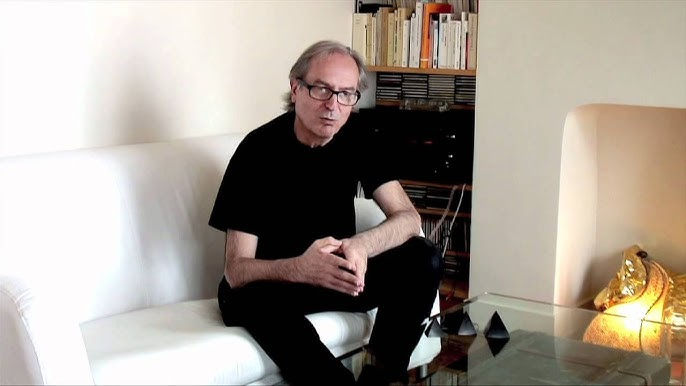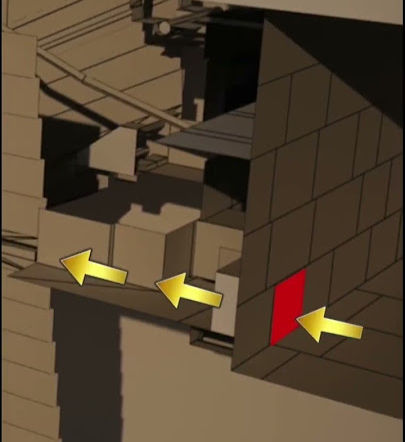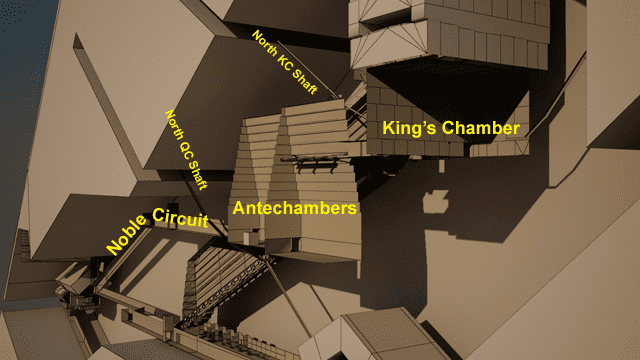The Great Pyramid’s Hidden Secrets
- Windfarer

- Aug 9
- 6 min read
Updated: Aug 18
A Journey to Unravel Khufu’s Genius
By he, August 2025
Imagine standing before the Great Pyramid of Giza, its golden limestone gleaming under the Egyptian sun, a 481-foot testament to human ambition built for Pharaoh Khufu around 2580 BCE. Over 2.3 million stone blocks, some as heavy as 80 tons, are stacked with such precision that a credit card can’t slip between them. How did the ancient Egyptians, armed only with ropes, sledges, and sheer ingenuity, construct this wonder in just 10–20 years? For centuries, scholars have wrestled with this question, proposing giant ramps or cranes, only to see their theories crumble under scrutiny. Then came Jean-Pierre Houdin, a French architect whose internal ramp theory weaves a compelling tale of engineering brilliance. With tantalizing clues like the “Big Void” and whispers of hidden antechambers, we’re on the cusp of a discovery that could rival Tutankhamun’s tomb—an Indiana Jones-worthy adventure into the heart of history.

Man fears time, but time fears the pyramids.
The Puzzle That Defies Time
Picture the Giza Plateau 4,500 years ago: thousands of workers toiling under the blazing sun, hauling limestone and granite blocks to create a monument for eternity. The Great Pyramid’s construction required moving thousands of stones daily, each placed with near-mathematical precision. How was it done? Traditional theories have tried to solve this riddle, but they falter under the weight of logic and evidence.
The Giant External Ramp Myth:
One popular idea suggests workers dragged stones up a massive ramp—either a straight slope or one spiraling around the pyramid. A straight ramp to the top would stretch over a mile to maintain a gentle 10-degree slope, demanding millions of cubic meters of material—almost as much as the pyramid itself. Constructing and dismantling such a ramp would have taken years, diverting resources from the main project. A spiraling ramp, wrapping the pyramid’s exterior, would block access to the sides, risking structural flaws as workers struggled to maneuver. Worse, no significant ramp debris or foundations have been found at Giza, despite extensive excavations. The logistics are a nightmare, and the evidence is absent.
Cranes and Levers Fall Short:
Another theory proposes wooden cranes or levers lifted the stones. But in Khufu’s time, wooden tools and ropes couldn’t reliably handle 80-ton granite blocks at great heights without snapping or splintering. No archaeological traces of such advanced lifting devices exist, and the wear on ropes would have slowed construction to a crawl, clashing with the pyramid’s tight timeline of a decade or two.
Brute Force Alone? Unlikely:
Some imagine thousands of workers dragging stones up the pyramid’s sides without ramps, relying on sheer manpower. This ignores the precision needed to align blocks perfectly, the lack of wear marks on the pyramid’s smooth exterior, and the physical toll of moving multi-ton stones up steep inclines. It’s a romantic notion, but it doesn’t explain the speed or accuracy.
These theories collapse under their own weight—too much material, too little evidence, or too far removed from the Egyptians’ known tools. The Great Pyramid demanded a solution as ingenious as the monument itself, one that Jean-Pierre Houdin’s theory delivers with breathtaking clarity.

Architect Jean Pierre Houdin
Houdin’s Vision: A Hidden Ramp and Ancient Engineering
In 2003, Jean-Pierre Houdin, a French architect with a passion for puzzles, proposed a game-changing idea: the Egyptians built the pyramid using an **internal ramp**—a spiral tunnel carved within the pyramid’s outer walls. Workers hauled stones up this hidden pathway as the structure rose, eliminating the need for a colossal external ramp. But Houdin’s theory doesn’t stop there. For the pyramid’s lower levels, up to about 60 meters (roughly 40% of the height), he suggests a smaller external ramp was used to place the larger, heavier blocks at the base. This modest ramp likely straight and far less resource-intensive than a full-scale one—handled the early stages before the internal ramp took over for the upper, narrower sections.
Houdin’s theory is a masterstroke of logic and evidence:
Efficiency at Its Core:
The smaller external ramp required minimal material compared to a mile-long monster, fitting the project’s timeline. The internal ramp, hidden inside the pyramid, needed no dismantling, leaving no debris to puzzle modern archaeologists. Workers could operate in the shade, a practical boon in Egypt’s heat.
Tangible Clues:
In the 2000s, a notched opening was found in the pyramid’s northeast corner, precisely where Houdin predicted an entrance to the internal ramp. Microgravimetry scans, which detect density variations, have revealed low-density zones inside the pyramid, consistent with a spiral tunnel.
The Grand Gallery’s Secret:
The **Grand Gallery**, a soaring 28-foot-high corridor leading to the King’s Chamber, is no mere hallway. Its massive granite beams, fitted with grooves for ropes, suggest it housed a counterweight system—an ancient “elevator” that used heavy weights to hoist 80-ton blocks up the ramp. This explains how the Egyptians moved massive stones to the pyramid’s core with ease.
Houdin’s hybrid approach—small external ramp for the base, internal ramp for the rest—marries practicality with genius. It leverages the pyramid’s own structure, aligns with the Egyptians’ tools (ropes, sledges, and manpower), and accounts for the absence of external ramp remains.
The Big Void: A Window Into the Past
In 2017, the *ScanPyramids Project* made headlines by detecting a 30-meter-long cavity above the Grand Gallery using muon tomography, a technique that tracks cosmic rays to reveal hidden spaces. Dubbed the *Big Void*, this mysterious chamber could be another counterweight space, mirroring the Grand Gallery’s role in Houdin’s model. Imagine workers pulling ropes, their chants echoing as granite blocks glide up the ramp. This discovery bolsters Houdin’s theory, suggesting the pyramid hides a network of functional chambers designed for construction. No other theory explains this void so seamlessly, painting a picture of an engineering marvel planned with meticulous care.
The Antechamber Dream: Treasures Behind a Stone.
Houdin’s most thrilling claim is that the Great Pyramid conceals *antechambers*- small, sealed rooms near the King’s Chamber, untouched for 4,500 years. An antechamber is a secondary space in a tomb, often used to store grave goods, ritual items, or even the pharaoh’s mummy to protect it from looters. Houdin points to a specific *non-load-bearing stone* in the King’s Chamber wall, meaning it doesn’t support the pyramid’s weight above and could be a movable door to a hidden passage.

Close your eyes and picture the moment: archaeologists, hearts pounding, carefully shift the stone. Dust swirls in the torchlight, revealing a narrow tunnel. Inside, sealed chests gleam with gold—statues of Anubis, intricately carved ushabti figures, papyrus scrolls etched with Khufu’s decrees, or even his intact sarcophagus, its lid still sealed. The potential finds are staggering:

- Royal Treasures: Golden scepters, amulets adorned with turquoise and lapis lazuli, or statues of gods like Osiris, revealing the Old Kingdom’s artistry and spiritual depth.
- Construction Secrets: Papyrus logs detailing the workforce, tools, or ramp system, offering a blueprint of how the pyramid was built and confirming Houdin’s vision.
- Funerary Offerings: Vessels filled with preserved food, model boats for the afterlife, or ceremonial weapons, painting a vivid picture of Egyptian beliefs about the journey beyond death.

This would be a find to rival Howard Carter’s 1922 discovery of Tutankhamun’s tomb—a heart-stopping moment that could explain why the King’s Chamber is so bare and whether Khufu’s mummy was hidden elsewhere. It’s the kind of adventure that would make Indiana Jones tip his hat in awe.
Why Houdin’s Theory Reigns Supreme
Houdin’s internal ramp theory, with its smaller external ramp for the lower levels, outshines its rivals by solving their fatal flaws. Giant external ramps demand absurd resources and leave no trace; cranes rely on unproven technology; brute force can’t account for the pyramid’s precision or speed. Houdin’s model, however, uses the pyramid’s own structure, aligns with physical clues like the notched corner and Big Void, and reflects the Egyptians’ knack for elegant solutions. It’s a story of ingenuity, backed by science, that feels as thrilling as the pyramid itself.

The Promise of Discovery
An intact antechamber would be more than a treasure trove—it would be a time machine. Scrolls could reveal the pyramid’s construction secrets, from the number of workers to the exact path of the internal ramp. Artifacts might illuminate the Old Kingdom’s religion, economy, and daily life, giving us a glimpse into Khufu’s world. Such a find would rewrite history books, spark global awe, and prove the Great Pyramid still guards wonders after millennia.
The Call of Adventure
The Great Pyramid is more than stone—it’s a story waiting to unfold. Jean-Pierre Houdin’s internal ramp theory, with its clever smaller external ramp, outshines the rest, backed by clues like the Big Void and the promise of hidden antechambers. If that non-load-bearing stone hides a sealed room, we’re one heartbeat from a discovery as epic as Tutankhamun’s tomb. Imagine holding Khufu’s treasures, unlocking the secrets of how the Egyptians built the impossible. The pyramid whispers its mysteries—are you ready to listen?
Explore the Mystery
- Jean-Pierre Houdin’s TED Talk: Houdin explains his internal ramp theory https://www.youtube.com/watch?v=5sB3KGlwi6Q
- ScanPyramids Project: Details on the Big Void discovery
- Khufu Reborn by Dassault Systèmes: A 3D model of Houdin’s theory
- National Geographic: Pyramid Secrets: Context on Giza’s mysteries https://www.nationalgeographic.com/history/article/great-pyramid-giza
All links were verified as functional on August 9, 2025.




Comments